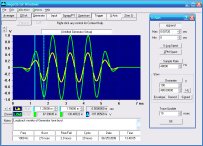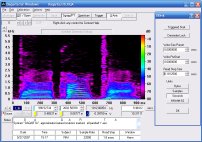![[LogoShip]](logo5.png)
Software for Windows
Science with your Sound Card!


Features:
Oscilloscope
Spectrum Analyzer
8-Channel
Signal Generator
(Absolutely FREE!)
Spectrogram
Pitch Tracker
Pitch-to-MIDI
DaqMusiq Generator
(Free Music... Forever!)
Engine Simulator
LCR Meter
Remote Operation
DC Measurements
True RMS Voltmeter
Sound Level Meter
Frequency Counter
Period
Event
Spectral Event
Temperature
Pressure
MHz Frequencies
Data Logger
Waveform Averager
Histogram
Post-Stimulus Time
Histogram (PSTH)
THD Meter
IMD Meter
Precision Phase Meter
Pulse Meter
Macro System
Multi-Trace Arrays
Trigger Controls
Auto-Calibration
Spectral Peak Track
Spectrum Limit Testing
Direct-to-Disk Recording
Accessibility
Data Logger
Waveform Averager
Histogram
Post-Stimulus Time
Histogram (PSTH)
THD Meter
IMD Meter
Precision Phase Meter
Pulse Meter
Macro System
Multi-Trace Arrays
Trigger Controls
Auto-Calibration
Spectral Peak Track
Spectrum Limit Testing
Direct-to-Disk Recording
Accessibility
Applications:
Frequency response
Distortion measurement
Speech and music
Microphone calibration
Loudspeaker test
Auditory phenomena
Musical instrument tuning
Animal sound
Evoked potentials
Rotating machinery
Automotive
Product test
Contact us about
your application!
Board Preparation
After drilling from the top side, the holes on the metal side of the board will now have rough edges from the dental burr piercing through. You must sand these smooth to the touch, without scratching up the rest of the copper surface. The best way to do this is by wet-sanding with a small piece of "Wet-or-Dry" sandpaper, 400 grit or so. (This is the black or dark gray paper.) Rinse frequently while you are sanding. The same scrap of paper can be used repeatedly for many boards.
Next, the copper surface must be scoured clean to remove any oils or oxidation that didn't come off in the sanding. Use a regular kitchen-type steel wool / soap pad like "Brillo" or "SOS" for this, then wash the board with a drop of dish detergent and rinse thoroughly to remove traces of soap and steel fibers. You may want to try other scouring pads like "Scotch-Brite", etc, which can be used directly with dish detergent.
Alternatively, you can use a small tuft of very fine (grade 00 or finer) steel wool with a drop of dish detergent. Again, make sure you rinse off all stray steel fibers as well as the detergent.
Dry with a clean towel... the copper should have a soft shine. Avoid touching the surface.
See also Printed Circuit Construction
- Back to Marking and Drilling
- Ahead to Drawing Resist Lines
- Daqarta Help Contents
- Daqarta Help Index
- Daqarta Downloads
- Daqarta Home Page
- Purchase Daqarta
Questions? Comments? Contact us!
We respond to ALL inquiries, typically within 24 hrs.INTERSTELLAR RESEARCH:
Over 35 Years of Innovative Instrumentation
© Copyright 2007 - 2023 by Interstellar Research
All rights reserved